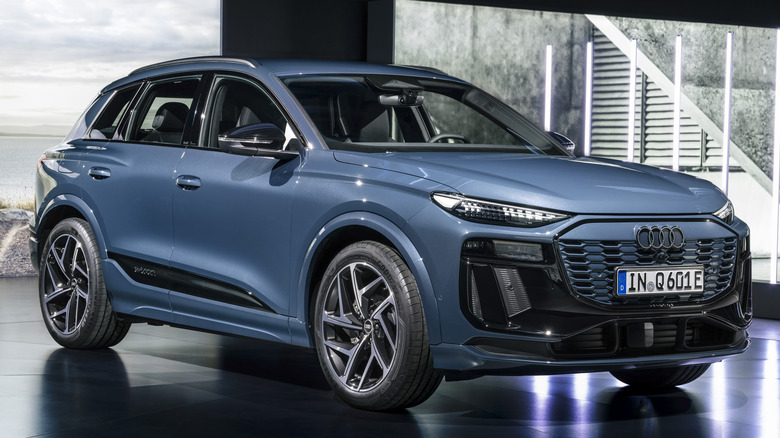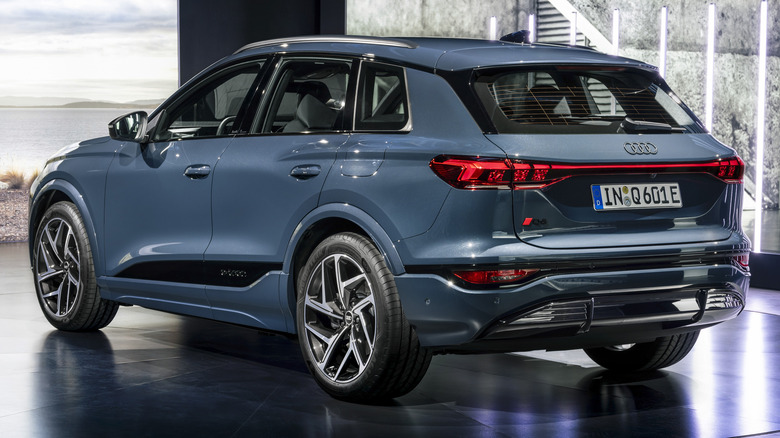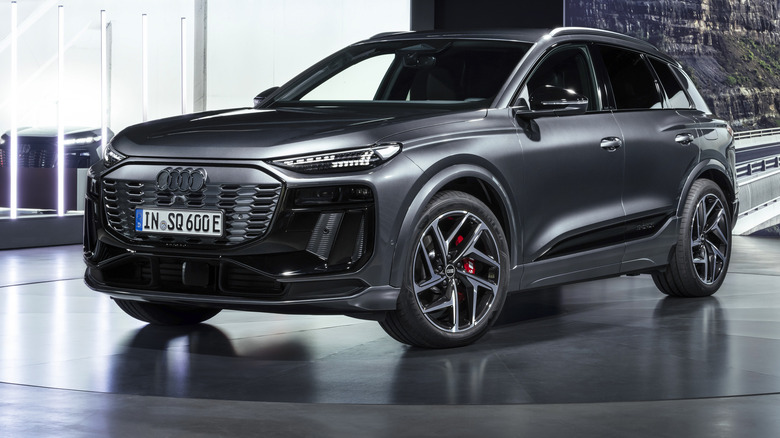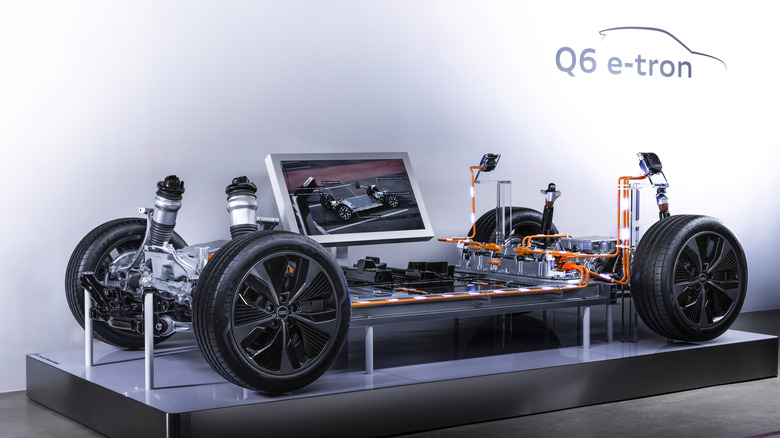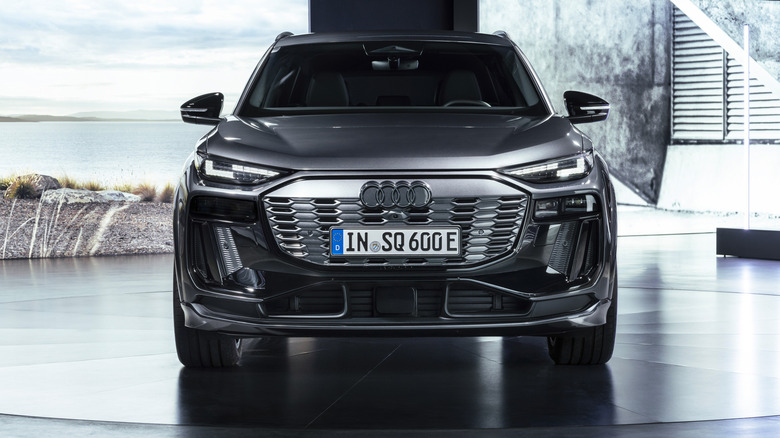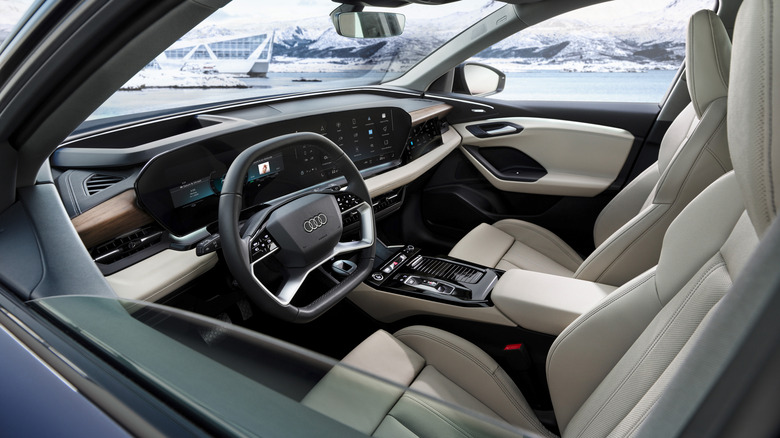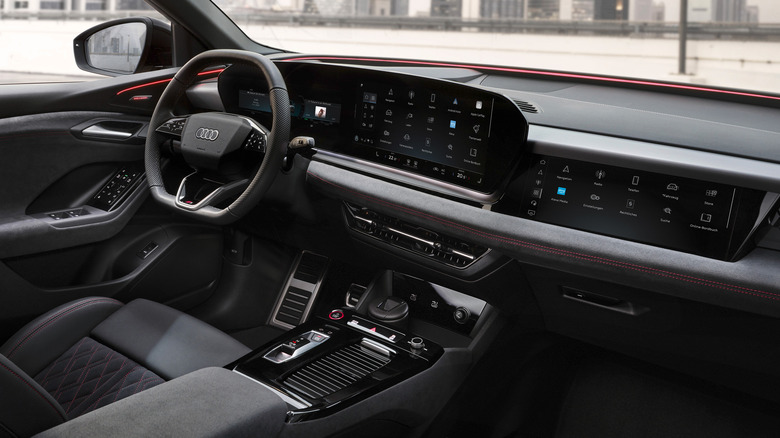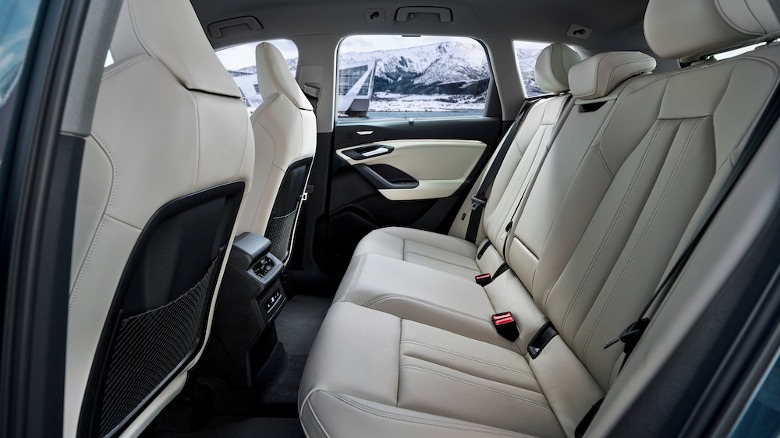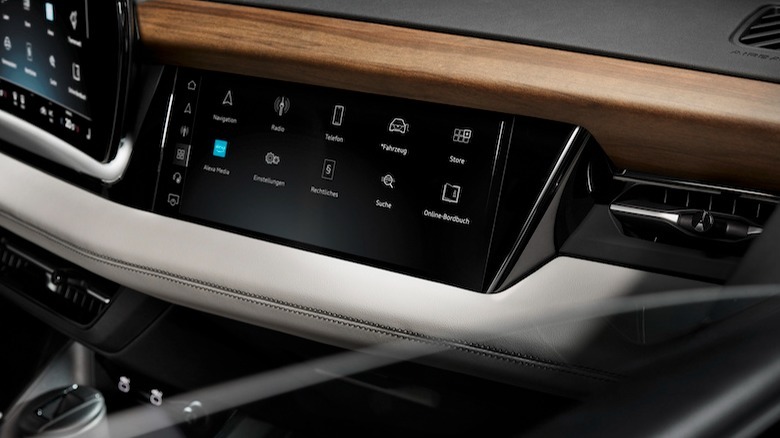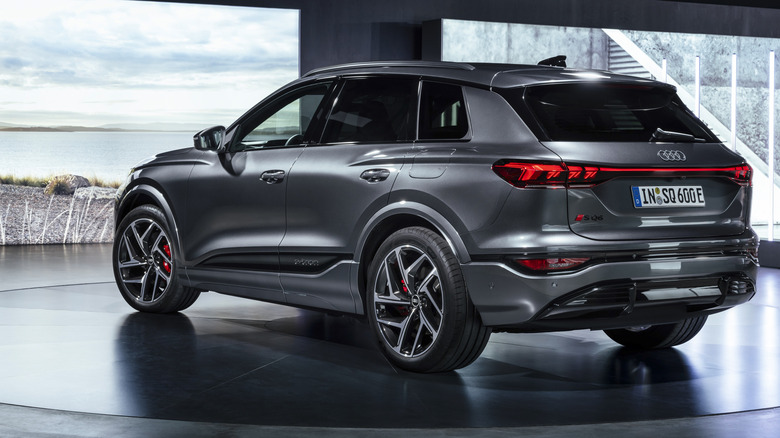2025 Audi Q6 E-Tron First Look: Price, Performance, Range (And Why This EV Is Special)
Audi's EV lineup is adding a fourth model, but the 2025 Q6 e-tron SUV will be more revolution than simple expansion when it arrives in the U.S. at the end of the year. Aimed directly at the lucrative — and growing — luxury midsize electric crossover category, it'll be more attainable than the larger Q8 e-tron, and more practical than the smaller Q4 e-tron. It'll also be the flag-bearer for the next-generation of Audi EVs.
That's because while the Q6 e-tron debuts an updated design language for Audi — both on the outside, and in a completely revamped and higher-tech interior — what's most important is underneath the sheet metal. The new EV is based on the Premium Platform Electric, or PPE; the all-electric architecture for high-end vehicles that Audi co-developed with Porsche. In fact, we've already seen Porsche's first application of that platform, as the new electric Macan uses the PPE.
Platform sharing clearly isn't new, mind, and so the Q6 e-tron is a different beast to the new Macan. The two electric SUVs are similar in length and width, but the Audi is about an inch taller than the Porsche. The new Macan will also be the speedier of the two cousins, though Audi will counter that with more cabin space.
New style, magical lights, and American disappointment
Instantly recognizable as an Audi, the Q6 e-tron measures in at 15.6 feet long, 6.5 feet wide, and 5.4 feet tall. That makes it slightly longer and wider than the current Q5; however, its 9.5 foot wheelbase is stretched in comparison. Short overhangs and muscular fenders — which Audi called "Quattro blisters" when it used them on the e-tron GT — emphasize the EV architecture, while the bulk of the battery under the cabin floor has been disguised somewhat with an insert section at the base of the doors. Wheels from 18 to 21-inches will be available, depending on trim and package.
At the front, the brand's Singleframe grille has been inverted: a black frame with a closed white inner-section. It's flanked by new Matrix LED digital light clusters, with twelve segments that can be individually lit and dimmed for up to eight patterns. At the rear, six new OLED lamps in the clusters can use their combined 360 segments to generate new patterns, as well as be turned into communication tools.
For example, the rear OLED screens can show warning symbols to traffic behind the Q6 e-tron, should there be an accident or other issue up ahead. Unfortunately for U.S. drivers, neither the front or rear systems will be active, as Audi — like other automakers — attempts to navigate through the NHTSA's updated rules on adaptive lighting. Instead, owners will be able to choose fixed patterns front and rear to display, though only when the EV is parked.
Two versions to start, including a potent SQ6 e-tron
Initially, there'll be two versions of the EV. In the U.S., the 2025 Q6 e-tron Quattro will have two electric motors for all-wheel drive, tuned for a total of 315 kW (422 horsepower) or up to 340 kW (456 horsepower) in boost mode. That's good for a 0-60 mph time of around 5.0 seconds, Audi says, and a 130 mph top speed. Steel suspension is standard, with air suspension as an option.
The SQ6 e-tron, meanwhile, will have 360 kW (483 horsepower), or up to 380 kW (510 horsepower) in boost mode, trimming the 0-60 run to 4.2 seconds, while top speed nudges up to 142 mph. It'll have air suspension as standard. Each has a roughly 4,400 pound towing rating.
Both versions have a 100 kWh battery — 94.9 kWh is usable — though U.S. EPA range numbers won't land until closer to the vehicles' release. On the WLTP test cycle, though (which tends to be more generous than the EPA's tests), the Q6 e-tron is expected to get up to 625 km (388 miles) on a full charge, while the SQ6 e-tron will do 598 km (372 miles). Audi is estimating that the Q6 e-tron will get more than 300 miles on the EPA test, with the sportier version coming in lower.
Later, Audi will also have a pair of rear-wheel drive Q6 e-tron models. One will be the most affordable option in the lineup, and the other will focus on maximizing efficiency and range. In addition to the 100 kWh battery pack, there'll also be an 83 kWh variant for more affordable EVs. It's likely that the U.S. will only get a long-range focused RWD model based on the larger battery.
Significantly faster charging
Though Audi has electric SUVs already, the Q6 e-tron will mark a leap ahead in charging. The PPE is built on 800 volt technology, and with a compatible DC fast charger, the Audi will support up to 270 kW rates. That could add 158 miles of range in 10 minutes, or take the 100 kWh battery from 10-80% in around 21 minutes, the automaker says.
Plug & Charge should make for more seamless charging experiences at compatible stations. At launch, the EV will have a CCS port, with Audi still working on how it'll offer an adapter for Tesla Superchargers. The automaker plans to offer native NACS ports on its new cars from 2025.
With 400 volt chargers, meanwhile, the PPE is capable of bank charging: effectively dividing the 800 volt battery into two 400 volt units, simultaneously charging at up to 135 kW. At home, meanwhile, up to 9.6 kW Level 2 charging is supported in the U.S., with AC charging ports on both sides of the car as standard (though there's only one DC fast charging port). Later, Audi plans to offer a 19.2 kW 80 amp option in the U.S. to halve home charging times.
For regenerative braking, as with other EVs, the Q6 e-tron will automatically blend recuperation via the electric motors with the SUV's physical brakes. That system — which prioritizes topping up the battery, before the physical brakes weigh in — supports up to 220 kW recuperation. Audi claims that 95% of typical braking operations can be done purely using regenerative braking, and the driver can adjust the levels on the fly using the steering wheel paddles. On-screen graphics show when you're using regenerative braking and when the physical brakes are active.
A new electrical backbone that's far more flexible
There's support for one-pedal driving (something we missed from the Q8 e-tron), which can bring the Q6 e-tron to a full stop, through to coasting with no deceleration that can be more efficient at highway speeds. Audi will also offer an auto deceleration mode, intelligently adjusting the regenerative braking depending on road conditions.
All of that power management is handled by the Q6 e-tron's new electronic platform, which Audi is calling "End-to-End Electronic Architecture" or E3 1.2. It consists of five domain computers distributed around the EV: one handling the drive system, another for driver assistance, a third for infotainment, and a fourth for comfort functions like lights, HVAC, and seating. The fifth is the hub for the others, all joined by gigabit ethernet, as well as managing over-the-air (OTA) updates courtesy of an embedded communications module.
It'll mean support for updates and fixes distributed to the Q6 e-tron without requiring it returning to a dealership, as well as new features being added over time. The EV will also be able to tap into cloud processing for system-intensive tasks.
Setting the Digital Stage in the cabin
Inside is where some of the most obvious improvements from current Audi SUVs can be found. The Q6 e-tron kicks off a reinvented cabin aesthetic for the automaker, with more soft-touch and recycled materials positioned in the places occupants are most likely to come into contact with. It also promises to be more spacious, with an 18.5 cubic-feet trunk (expanding to 53.9 cubic-feet with the rear seats folded) and a 2.2 cubic-feet frunk under the hood.
The dashboard — referred to as the Digital Stage — gets an 11.9-inch virtual cockpit for the driver's instrumentation, and a 14.5-inch MMI touch display in the center. Both OLED panels are enclosed in the same, upright section, curved and backlit with ambient lighting. A 10.9-inch MMI front passenger display can be used for multimedia, navigation, and locating charging stations. Like Mercedes uses on its EQS SUV's touchscreen, an Active Privacy Mode in the Audi prevents what's on-screen from distracting the driver.
Then there's a new, larger augmented reality head-up display (HUD), which Audi says gives the impression of a roughly 88-inch screen placed up to 656 feet from the driver. Effectively tilted with respect to the driver's vision — so that the top of the HUD is positioned further down the road than the bottom edge — it can apparently more effectively place virtual graphics atop the real-world scene. Audi will also preload two games that can be played on the HUD while you're waiting for the Q6 e-tron to charge.
Android underneath
Audi uses Android Automotive OS for its new infotainment system, with navigation (not Google Maps) and the e-tron route planner as standard. There's also Google Play store access, and preloaded apps like Spotify and YouTube. The central touchscreen is split, with a persistent climate control bar running along the bottom. A system bar on the left has shortcuts for different apps and services, and the remainder is dedicated to the app currently in use (which can include Android Auto or Apple CarPlay, with maps from each mirrored in the driver's display).
"Hey Audi" voice recognition offers natural language control over around 800 different features, with each supporting over 100 commands: a three-fold increase from the automaker's old system. Audi says it should also proactively learn from how it's used, predicting things like which routes or cabin climate settings are preferred, according to different contexts.
Drivers will be able to change drive modes, control the power windows and ambient lighting, and even switch on the reading lights by voice. Drivers can also ask general questions, plus have commands intuited such as increasing footwell heat simply by complaining "Hey Audi, my feet are cold."
Running around the top of the dashboard, under the edge of the windshield from A-pillar to A-pillar, is a multicolor light strip made up of 84 LEDs. These lights can animate according to things like EV charging, lock/unlock, and when the voice assistant is communicating.
An optional Bang & Olufsen Premium sound system will have 830 watts of amplification, powering 20 speakers. For the first time, four of these are positioned in the front headrests, so that the Q6 e-tron can direct audio into different cabin sound zones. Don't worry: despite the bigger touchscreen, there'll still be a physical volume knob, too.
U.S. pricing to be confirmed, but the roadmap is big
For U.S. drivers, the biggest question is just how much all this will cost. In Europe, the first examples of the Audi Q6 e-tron will go up for order this month, with deliveries kicking off in summer 2024. The Q6 e-tron Quattro will be priced from 74,800 euro ($82,000), while the SQ6 e-tron will be priced from 93,800 euro ($103,000).
U.S. pricing and availability — along with EPA range and final power numbers — will be confirmed closer to the EVs' launch, which is expected late in Q4 2024.
Down the line, there'll be both the rear-wheel drive models and Sportback variants, which — like the Q8 e-tron Sportback we reviewed recently — will trade a little practicality in favor of a more swooping roofline. Timing for those models hasn't been confirmed yet, nor for the seemingly-inevitable Audi RS Q6 e-tron, which will offer the most performance from the new EV.
